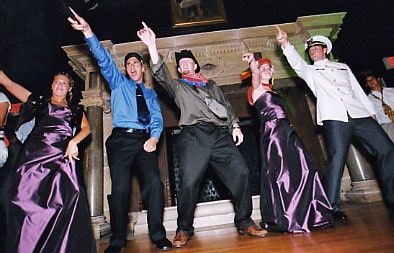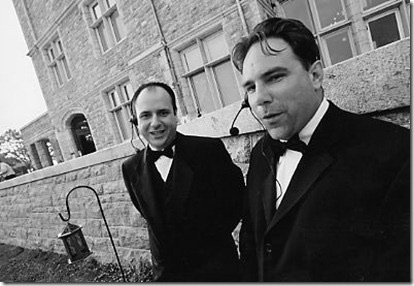After working as a wedding DJ for nearly 25 years, I thought I’d offer some thoughts and opinions on those songs often played at weddings that have a dance associated with them.
Here they are… the good, the bad, and the ugly:
The Macarena: This is the worst of all the group dances. In general, I believe that group dances are best when they afford the dancers some level of independence and creativity. The Macarena is the soulless repetition of a a dozen hand and arm movements, followed by a quick shake of the hips and a turn. Over and over and over again. Nothing changes. The song’s lyrics don’t tell the dancers what to do, but given that you barely move your feet, it isn’t hard for anyone to dance to this song.
But again, you barely move your feet. While dancing. It’s awful.
The Electric Slide: Slightly better than The Macarena in that it affords dancers the opportunity to move. You can quickly identify confident, skilled dancers from their less confident, less skilled brethren as they dance to this song. It still doesn’t afford much by way of creativity, but at least you can show off your ability to move your body with rhythm and purpose. Also, nothing in the lyrics to the song (actually called Electric Boogie) tells you what to do, so dancers of The Electric Slide need to have learned the song somewhere in order to participate, thus demonstrating a level of expertise that can be slightly appreciated.
The Hokey Pokey: It’s silly, stupid, and fantastic. Yes, the song’s lyrics actually dictate the dancer’s movements, but there is enormous flexibility in this regard. “Put your right hand in” can be a simply jab of the arm or something much more elaborate and creative. Naysayers will see the Hokey Pokey as ridiculous and stupid, but I advise you to check your pretentious attitude at the door and have some fun with this excellent dance.
The Chicken Dance: Brace yourself for this knowledge drop: This is the best of the group dances. I know, it’s silly. Designed for children more than adults. Nonsensical and corny. Also incredibly fun. During the chorus (which contains no words), there are no rules. Do whatever you’d like. Fly like a chicken. Do-si-do . Grind up against a willing partner. Drag people from their seats. Break dance. The Chicken Dance declares, “We are here to have fun, damn it, and we sure as hell aren’t taking ourselves too seriously.”
The Cha Cha Slide: The Cha Cha Slide affords more opportunities for creativity than the original Electric Slide, primarily because phrases like “Charlie Brown!” and “Turn it out!” are very much open for interpretation. The lyrics also tell you what to do, so people with little or no knowledge of the song can participate, making it more accessible than The Electric Slide, but damn it’s long.
Party Train (The Locomotion, Hot Hot Hot, Conga): I strongly support a party train of some kind. It allows for enormous creativity, both from the person leading the party train as well as those dancing in the line. It’s also an excellent opportunity to drag those folks from their seats who want to dance but are less confident and need some encouragement. Party trains are best when launched spontaneously. If a DJ needs to organize a party train, it doesn’t feel nearly as good.
Cotton Eye Joe: Cotton Eyed Joe (the Rednex version) is a traditional country song updated in 1994 by a Swedish dance group. Though it sounds like something more modern, the actual dance is still a country line dance. I don’t support any of the country line dances. They afford no creativity and are often done as automatically and dispassionately as the equally awful Macarena. Don’t be fooled by the song. It’s country line dancing in disguise.
Time Warp: The Time Warp is a song and dance from the film The Rocky Horror Picture Show, making it a much loved cult hit by a small but enthusiastic group of people, myself included. I’m a card carrying member of The Rocky Horror Picture Show fan club and have attended the live version of this movie many times as well as the Broadway show, so I may be biased here, but this song is quite fun. Parts of the song are instructive, but others allow for creativity, which strikes me as the perfect balance for a group dance. It also instructs dancers to perform a pelvic thrust at various times, which is always fun and amusing.
YMCA: In most instances, this song invites dancers to reproduce the letters Y-M-C-A with their arms, which is fine. Amusing and easy. But there is a more complex version of this dance that my DJ partner, Bengi and I, would teach and lead at weddings. We would also dress up members of the bridal party as the Village People and have them perform for the wedding. But given that almost no one knows the actual dance, the reproduction of the letters of Y-M-C-A is simple and allows everyone to participate while also dancing to a good song, making it an excellent choice for most weddings.
The Cupid Shuffle: This is an excellent group song, combining instructive elements along with enormous amounts of independence and creativity. In many ways, it’s an upgraded version of The Electric Slide, affording more opportunities to show off skills while also making it accessible for all.
There are other group songs, of course. Some might consider songs like The Twist, Twist and Shout, and Sweet Caroline group dances, but I think of those as songs with specific dance moves that you can opt to do or not and still enjoy.
There are also hip hop group sings like Tootsie Roll and The Wobble that I have never seen done in person, but you can see them performed online, so presumably they are done somewhere. I’ve played those songs many times, but no one has ever done or attempted to do these dances, so formulating any kind of opinion on them isn’t possible.
Many of the couples for whom I work avoid all of these songs, which is fine. You don’t need group dances. But there is one advantage to playing a few of them.
Even the stupid, soulless, mind-numbing Macarena.
Not everyone at a wedding is a confident dancer. Many people don’t dance because they worry about looking foolish or inexperienced. The spotlight effect, a term used by social psychologists to refer to the tendency we have to overestimate how much other people notice about us, is on full display on the dance floor.
It’s a terrible shame, of course, because dancing requires little more than confidence. No one really cares what you’re doing as long as you are having fun.
For some of those less confident or even unwilling dancers, these group songs afford them an opportunity to join their friends on the dance floor for something a little less intimidating. Rather than having to do something original, they simply need to follow instructions, which is another reason why I like The Chicken Dance and The Hokey Pokey so much.
No one expects you to look cool while dancing to these songs.
Dancing to a group song oftentimes breaks the ice for some of these more hesitant guests, allowing them to dance the night away, especially if the DJ follows one of these group dances with a popular, infectious, sing-along song that will keep these hesitant dancers dancing.









